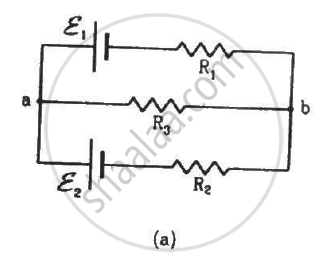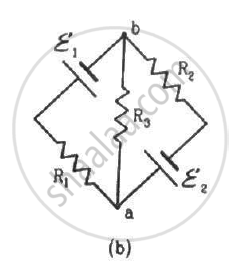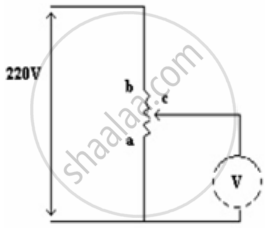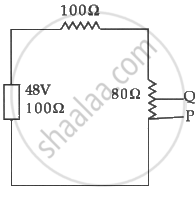Advertisements
Advertisements
Question
A 6-volt battery of negligible internal resistance is connected across a uniform wire AB of length 100 cm. The positive terminal of another battery of emf 4 V and internal resistance 1 Ω is joined to the point A, as shown in the figure. Take the potential at B to be zero. (a) What are the potentials at the points A and C? (b) At which point D of the wire AB, the potential is equal to the potential at C? (c) If the points C and D are connected by a wire, what will be the current through it? (d) If the 4 V battery is replaced by a 7.5 V battery, what would be the answers of parts (a) and (b)?

Solution
(a) Potential difference across AB = Potential at A - Potential at B
Potential at B = 0 V
⇒ Potential at point A = Potential difference across AB = 6 V
⇒ Potential difference across AC = Potential at A - Potential at B
⇒ 4 = 6 - Potential at C
⇒ Potential at C = 2 V
(b) Given:-
Potential across AD = Potential across AC = 4 V
⇒ Potential across DB = 2 V
\[\frac{V_{AD}}{V_{BD}} = \frac{l_{AD}}{l_{DB}}\]
\[ \Rightarrow \frac{4}{2} = \frac{l_{AD}}{100 - l_{AD}}\]
\[ \Rightarrow 4\left( 100 - l_{AD} \right) = 2 l_{AD} \]
\[ \Rightarrow 6 l_{AD} = 400\]
\[ \Rightarrow l_{AD} = \frac{400}{6} = 66 . 7 cm\]
(c) When the points C and D are connected by a wire, current flowing through the wire will be zero because the points are at the same potential.
(d) Potential difference across AC = Potential at A - Potential at C
⇒ 7.5 = 6 - Potential at C
⇒ Potential at C = −1.5 V
Since the potential at C is negative now, this point will go beyond point B, which is at 0 V. Hence, no such point D will exist between the points A and B.
APPEARS IN
RELATED QUESTIONS
When 5 V potential difference is applied across a wire of length 0.1 m, the drift speed of electrons is 2.5 x 10-4 m/s. If the electron density in the wire is 8 x 1028 m-3, calculate the resistivity of the material of the wire.
In a series LCR circuit, what is the phase difference between VL and VC where VL is the potential difference across the inductor and V c is the potential difference across the capacitor?
Describe the working principle of a solar cell. Mention three basic processes involved in the generation of emf.
Why is potentiometer preferred over a voltmeter for comparison of emf. of cells?
The emf of a cell is always greater than its terminal voltage. Why? Give reason.
The following figure shows a part of a circuit. If a current of 12 mA exists in the 5 kΩ resistor, find the currents in the other three resistors. What is the potential difference between the points A and B?

Find the potential difference Va – Vb in the circuits shown in the figure.


In the circuit shown in the figure, ε1 = 3 V, ε2 = 2 V, εa = 1 V and r1 = r2 = r3 = 1Ω. Find the potential difference between the points A and B and the current through each branch.

A voltmeter of resistance 400 Ω is used to measure the potential difference across the 100 Ω resistor in the circuit shown in the figure. (a) What will be the reading of the voltmeter? (b) What was the potential difference across 100 Ω before the voltmeter was connected?

If a constant potential difference is applied across a bulb, the current slightly decreases as time passes and then becomes constant. Explain.
A copper strip AB and an iron strip AC are joined at A. The junction A is maintained at 0°C and the free ends B and C are maintained at 100°C. There is a potential difference between _______________ .
(a) the two ends of the copper strip
(b) the copper end and the iron end at the junction
(c) the two ends of the iron strip
(d) the free ends B and C
The potential difference across the terminals of a battery of emf 12 V and internal resistance 2 Ω drops to 10 V when it is connected to a silver voltameter. Find the silver deposited at the cathode in half an hour. Atomic weight of silver is 107.9 g mol−1.
A potential difference of 220 V is maintained across 12000 Ω rheostat. Then voltmeter V has a resistance of 6000 Ω and point C is at one fourth the distance from a to b. Then the reading of voltmeter is ______.

In the circuit in figure the potential difference across P and Q will be nearest to

Two sources of equal e.m.f are connected to an external resistance R in series. The internal resistance of the two sources are R1 and R2 (R2 > R1) If the potential difference across the source having internal. resistance R2 is zero, then ______.
The terminal potential difference of a cell is greater than its e.m.f when it is ______
